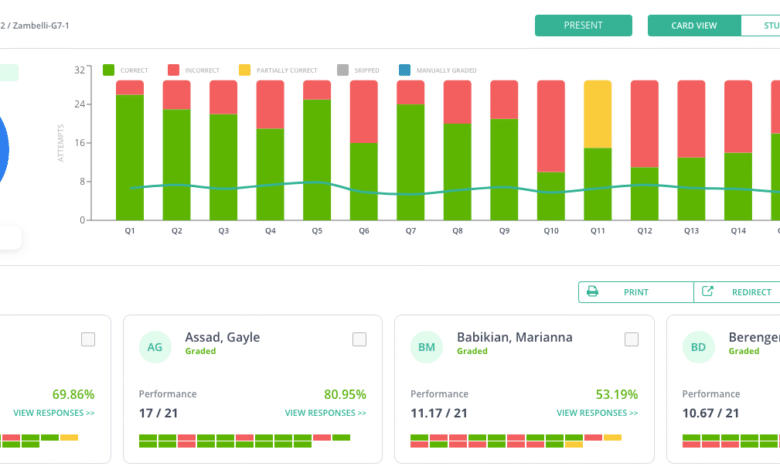Understanding the Pear Assessment: A Comprehensive Guide

Introduction to Pear Assessment
The pear assessment is a structured evaluation tool designed to gauge various aspects of student development and performance within educational settings. This assessment serves as an essential mechanism for educators to understand students’ strengths, weaknesses, and overall capabilities. By utilizing a pear assessment, educators can tailor their teaching methods, ensuring that each student receives the support and resources necessary to thrive academically and personally. The primary purpose of this assessment is to foster improvements in student learning outcomes and promote holistic development.
In educational environments, the pear assessment plays a critical role in identifying areas needing reinforcement or additional support. Through the data collected from this assessment, educators can gain insights into individual learning styles and preferences, which can lead to more personalized educational approaches. It is not merely a tool for grading; rather, it emphasizes each student’s potential and guides instructional strategies aimed at maximizing learning efficiency.
The instruments used in the pear assessment vary widely in their application and design, encompassing various methodologies to accommodate diverse learning needs. These instruments can include interviews, standardized tests, observational checklists, and performance tasks. Each component is carefully structured to provide accurate and comprehensive data regarding a student’s academic abilities and personal growth. Consequently, the integration of such methodologies paves the way for a multifaceted understanding of student performance derived from the pear assessment.
In summary, the pear assessment is a vital educational tool that underscores the need for a personalized learning experience, allowing educators to work effectively with students to enhance learning processes. As we delve deeper into the subsequent sections of this guide, the significance and implementation intricacies of the pear assessment will be explored further.
The Importance of Pear Assessment in Education
The pear assessment plays a critical role in educational settings as it provides invaluable insights into students’ learning abilities. Through the utilization of this assessment method, educators can effectively identify individual student strengths and weaknesses. This identification process is essential, as it allows teachers to tailor their instructional strategies to meet the diverse needs of their students, fostering a more inclusive learning environment.
One of the primary advantages of the pear assessment is its ability to generate detailed data regarding student performance across various subjects. This data empowers educators to recognize patterns in academic achievement and pinpoint areas that may require additional support or intervention. By applying this information, teachers can modify lesson plans, adjust pacing, and select appropriate resources that cater to different learning styles. Consequently, this personalized approach enhances student engagement and promotes a deeper understanding of the material.
Moreover, the implementation of pear assessments also contributes to an environment of continuous growth and development for both students and educators. Teachers can monitor progress over time, enabling them to assess the effectiveness of their instructional strategies and make informed adjustments as necessary. This iterative process is crucial for promoting academic achievement and ensuring that all students are progressing towards their individual learning goals.
The influence of pear assessments extends beyond the individual classroom; they serve as a vital tool for institutional improvement as well. By analyzing aggregate data collected from assessments, educational leaders can discern broader trends and allocate resources more effectively. This holistic perspective on student performance can drive initiatives that enhance overall educational outcomes, benefiting entire school communities.
In conclusion, the significance of pear assessment in education cannot be overstated. This valuable tool informs teaching strategies, fosters student growth, and supports continuous improvement in academic environments, ultimately leading to enhanced learning experiences for all.
Components of Pear Assessment
The pear assessment encompasses several critical components that contribute to a comprehensive evaluation of students. Understanding these components is vital for educators looking to implement effective pear assessments in their curriculum. One of the fundamental types of assessments involved is formative assessment, which occurs during the learning process. This type helps to monitor student progress and provides ongoing feedback that can inform instructional decisions.
Another important type is summative assessment, which evaluates student learning at the end of an instructional unit. This type focuses on measuring whether students have gained the intended knowledge and skills. Evaluations can take various forms, including written tests, projects, presentations, and portfolios, each providing insights into different aspects of student understanding.
When conducting a pear assessment, certain criteria need to be established to ensure that evaluations are fair and comprehensive. These criteria often include clarity of objectives, alignment with curriculum standards, and relevance to real-world applications. Furthermore, it is essential to consider the diversity of learning styles among students. By accommodating various approaches to learning, the assessment can more accurately reflect student abilities.
The methodology utilized to evaluate students is equally important in a pear assessment framework. Effective implementation involves a blend of qualitative and quantitative measures. For instance, scoring rubrics can help standardize the evaluation process, providing clear expectations for students while ensuring objectivity in grading. Additionally, incorporating peer assessments and self-evaluations encourages students to engage in their own learning and reflect on their progress.
Ultimately, the components of pear assessment work together to provide a structured and meaningful approach to student evaluation, enhancing the educational experience for all parties involved. Understanding and effectively integrating these elements is essential for fostering a productive learning environment.
Administering the Pear Assessment
Administering a pear assessment requires careful preparation and execution to ensure that the results are reliable and valid. One of the first steps in this process is to familiarize oneself with the assessment tools and criteria. Educators must understand the foundational concepts behind the pear assessment, as well as the specific objectives it aims to achieve. This understanding is vital for creating an environment where students feel comfortable and motivated to perform to the best of their abilities.
Prior to administering the assessment, thorough preparation is essential. This includes organizing all necessary materials and ensuring that the assessment environment is conducive to concentration and focus. In practice, this means having a quiet space free from distractions, providing adequate seating, and ensuring that all required technological tools are functioning correctly. Additionally, educators should communicate clearly with students about what to expect, alleviating any anxiety or uncertainty they may have regarding the pear assessment.
Timing is also a crucial factor when administering a pear assessment. Educators should allocate sufficient time for each section of the assessment, taking into account the varied paces at which students may work. It is beneficial to allow time for questions before the assessment begins, ensuring that all students understand the instructions and are aware of the assessment format. Furthermore, it is important to monitor the testing conditions closely, to provide assistance as needed while still maintaining a fair environment for all students.
Finally, to ensure a fair and unbiased assessment process, educators should remain vigilant against potential biases that could influence results. This encompasses being aware of one’s own perceptions, providing equal opportunities regardless of students’ backgrounds, and implementing standardized procedures for all participants. By focusing on these best practices, the administration of the pear assessment can yield meaningful insights into students’ capabilities and areas for growth.
Interpreting Pear Assessment Results
Understanding the results of a pear assessment is crucial for educators, students, and parents alike. The assessment aims to evaluate students’ academic abilities, providing valuable insights into their strengths and areas for improvement. One of the first steps in interpreting these results involves familiarizing oneself with the scoring systems used in the assessment. Typically, scores are presented in a standardized format that indicates where a student falls relative to their peers, allowing for effective comparison. This scoring may include percentile ranks, developmental scales, or raw scores, depending on the specific design of the pear assessment.
Once the scoring system is understood, the next step is to read the accompanying reports carefully. These reports typically include detailed breakdowns of strengths in various subject areas as well as opportunities for growth. Educators should pay close attention to the narrative sections of these reports, as they can provide context behind the numerical values presented. Additionally, these reports may outline specific skills or knowledge areas assessed, facilitating a comprehensive understanding of a student’s performance. For example, if a student scores lower in critical thinking, it signals the need for targeted interventions to build that skill.
Interpreting pear assessment results goes beyond mere score analysis; it involves recognizing the implications for the student’s academic journey. Such assessments can guide future educational plans by identifying necessary support systems or enrichment opportunities. For educators, these insights are essential for developing individualized learning strategies that address each student’s unique needs. By fully understanding and embracing the results of a pear assessment, stakeholders can collaboratively foster an environment that promotes academic growth and success for every student.
Common Challenges in Pear Assessment
Pear assessments are crucial in evaluating student academic performance and social-emotional development. However, several challenges often arise, impacting the effectiveness of these evaluations. One prominent issue is student anxiety. Many individuals experience heightened stress during assessments, which can lead to performance that does not accurately reflect their abilities. This anxiety is often fueled by the pressure to succeed, fear of failure, or a lack of familiarity with the assessment environment. Educators and assessors must acknowledge this anxiety and work to create a supportive atmosphere that encourages students to perform to the best of their abilities.
Another challenge relates to biases in assessment. Various factors, including cultural background and socio-economic status, can affect how students are evaluated. Traditional pear assessments may not always account for the diverse needs of all learners, potentially disadvantaging certain groups. It is essential for educators to remain conscious of these biases and strive for a more equitable assessment process. Additionally, utilizing a variety of assessment tools can help mitigate the impact of bias and provide a more rounded evaluation of student capabilities.
The limitations of assessment tools also pose a significant challenge. While many pear assessment tools are designed to measure specific academic or developmental competencies, they may not capture the full scope of a student’s abilities. This limitation can lead to an incomplete or inaccurate picture of student performance. It is crucial for educators to use a combination of assessment methods, including formative assessments, portfolios, and observational assessments, to gain a comprehensive understanding of each learner’s strengths and weaknesses.
In addressing these challenges, educators can foster a more inclusive, supportive, and accurate pear assessment process. By recognizing student anxiety, implementing measures to reduce biases, and diversifying assessment tools, educators can enhance the reliability and validity of their evaluations, ultimately benefiting student outcomes.
Enhancing Pear Assessment Practices
Improving the effectiveness and reliability of pear assessments necessitates a multifaceted approach. Incorporating technology into the assessment process can significantly enhance its utility and accuracy. For instance, the use of online platforms for administering surveys and tests allows for real-time data analysis and immediate feedback. Digital tools can foster interactive assessments, providing students with immediate results and tailored learning pathways that address individual needs. Such technological integrations not only streamline the assessment administration but also encourage active engagement from students.
Another vital strategy is the incorporation of feedback loops. Establishing a system where students receive constructive feedback on their performance can drastically enhance the learning experience. By routinely collecting and analyzing responses, educators can refine their assessment strategies based on actual student outcomes. For example, if certain areas consistently show lower performance, educators can adapt their teaching methods or provide additional resources to cover these gaps. This continuous improvement cycle helps ensure that pear assessments remain relevant and effective in measuring student understanding.
Furthermore, engaging students in the pear assessment process itself is crucial. When learners understand the criteria by which they are being evaluated, they are more likely to take ownership of their learning. Involving students in discussion about the assessment criteria and allowing them to self-assess fosters a deeper comprehension of their own academic progress. This engagement not only motivates students but also enhances their ability to critically evaluate their work and recognize the skills necessary for improvement.
Collectively, these strategies – integrating technology, utilizing feedback loops, and fostering student engagement – form a comprehensive framework that can significantly enhance pear assessment practices. By implementing these methods, educators can ensure that assessments are not merely tests of knowledge but valuable resources for learning and development.
Real-world Applications of Pear Assessment
Pear assessments serve as a pivotal tool in various educational settings, offering valuable insights into student learning and instructional effectiveness. One prominent application can be found in special education, where educators utilize pear assessments to tailor educational plans for students with unique learning requirements. For instance, a case study from an urban school district revealed that educators implemented pear assessments to identify specific strengths and areas for improvement among students with learning disabilities. As a result, personalized interventions were developed, ultimately enhancing student engagement and academic performance.
In mainstream classrooms, pear assessments can track student progress over time. A noteworthy example is a middle school that incorporated regular assessments into its curriculum to evaluate student comprehension in subjects such as mathematics and science. By analyzing the results of these assessments, teachers were able to adapt their instructional methods and group students according to their learning needs. This approach not only fostered higher academic achievement but also created a more inclusive classroom environment.
Higher education institutions have also started to recognize the significance of pear assessments in gauging student readiness and skill acquisition. A university case study demonstrated that utilizing pear assessments in introductory courses allowed instructors to monitor student learning outcomes more effectively. By leveraging the data collected from these assessments, academic advisors could provide targeted support for students who struggled to meet course requirements, thereby increasing graduation rates and overall student satisfaction.
Overall, the versatility of pear assessments allows for their application across various educational contexts. Whether in special education, mainstream classrooms, or higher education, pear assessments facilitate informed decision-making and foster positive educational outcomes. This adaptability underscores the critical role that pear assessments play in enhancing the learning experience for students at all levels.
Future Trends in Pear Assessment
The field of educational assessment is continually evolving, and the pear assessment is no exception. As we look toward the future, various trends and innovations are shaping the methodologies used to evaluate a student’s understanding and performance. These emerging trends reflect advancements in technology, an increased focus on personalized learning, and a growing emphasis on holistic education.
One significant trend is the integration of technology into pear assessments. Digital platforms are increasingly being utilized to facilitate more dynamic assessment methods. Tools such as online simulations, interactive quizzes, and e-portfolios allow educators to create more engaging assessment environments. This technological shift not only improves accessibility but also offers real-time feedback, allowing students to reflect on their learning processes and outcomes promptly.
Moreover, there is a noticeable shift towards personalized assessments. Educators and institutions are beginning to recognize that standardized testing does not account for the diverse learning styles and paces of individual students. Future pear assessment practices may include adaptive testing, where questions are tailored to the student’s performance level, thus providing a more accurate representation of their abilities and knowledge.
Furthermore, a holistic approach to education is becoming prevalent, emphasizing the importance of not just academic achievement but also social-emotional learning and competencies. This shift encourages the incorporation of multifaceted assessments that evaluate a student’s collaboration, creativity, and critical thinking skills, alongside traditional academic metrics. As institutions embrace these innovative practices, the pear assessment will increasingly focus on fostering a more comprehensive educational experience.
In conclusion, the future of pear assessment will likely be characterized by technological integration, personalized learning experiences, and a holistic view of student development. By adopting these emerging trends, educators and institutions can enhance the effectiveness and relevance of assessments in a rapidly changing educational landscape.
You May Also Read This Bettermentbusiness.



